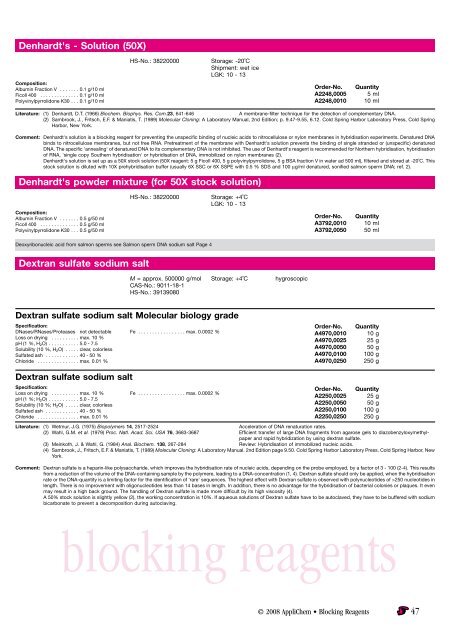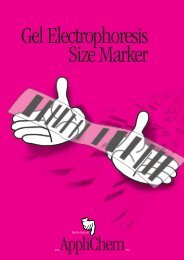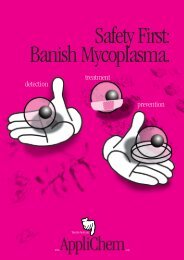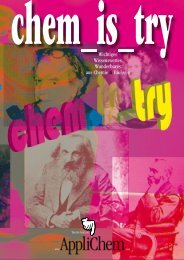Transfer Membranes
Transfer Membranes
Transfer Membranes
Create successful ePaper yourself
Turn your PDF publications into a flip-book with our unique Google optimized e-Paper software.
Denhardt's - Solution (50X)<br />
Composition:<br />
Albumin Fraction V . . . . . . . 0.1 g/10 ml<br />
Ficoll 400 . . . . . . . . . . . . . . 0.1 g/10 ml<br />
Polyvinylpyrrolidone K30 . . . 0.1 g/10 ml<br />
g<br />
HS-No.: 38220000<br />
Storage: -20˚C<br />
Shipment: wet ice<br />
LGK: 10 - 13<br />
Order-No. Quantity<br />
A2248,0005 5 ml<br />
A2248,0010 10 ml<br />
Literature: (1) Denhardt, D.T. (1966) Biochem. Biophys. Res. Com.23, 641-646 A membrane-filter technique for the detection of complementary DNA.<br />
(2) Sambrook, J., Fritsch, E.F. & Maniatis, T. (1989) Molecular Cloning: A Laboratory Manual, 2nd Edition; p. 9.47-9.55, 6.12. Cold Spring Harbor Laboratory Press, Cold Spring<br />
Harbor, New York.<br />
Comment: Denhardt's solution is a blocking reagent for preventing the unspecific binding of nucleic acids to nitrocellulose or nylon membranes in hybridisation experiments. Denatured DNA<br />
binds to nitrocellulose membranes, but not free RNA. Pretreatment of the membrane with Denhardt's solution prevents the binding of single stranded or (unspecific) denatured<br />
DNA. The specific 'annealing' of denatured DNA to its complementary DNA is not inhibited. The use of Denhardt's reagent is recommended for Northern hybridisation, hybridisation<br />
of RNA, 'single copy Southern hybridisation' or hybridisation of DNA, immobilized on nylon membranes (2).<br />
Denhardt's solution is set up as a 50X stock solution (50X reagent: 5 g Ficoll 400, 5 g polyvinylpyrrolidone, 5 g BSA fraction V in water ad 500 ml), filtered and stored at -20˚C. This<br />
stock solution is diluted with 10X prehybridisation buffer (usually 6X SSC or 6X SSPE with 0.5 % SDS and 100 mg/ml denatured, sonified salmon sperm DNA; ref. 2).<br />
Denhardt's powder mixture (for 50X stock solution)<br />
Composition:<br />
Albumin Fraction V . . . . . . . 0.5 g/50 ml<br />
Ficoll 400 . . . . . . . . . . . . . . 0.5 g/50 ml<br />
Polyvinylpyrrolidone K30 . . . 0.5 g/50 ml<br />
HS-No.: 38220000<br />
Storage: +4˚C<br />
LGK: 10 - 13<br />
Order-No. Quantity<br />
A3792,0010 10 ml<br />
A3792,0050 50 ml<br />
Deoxyribonucleic acid from salmon sperms see Salmon sperm DNA sodium salt Page 4<br />
Dextran sulfate sodium salt<br />
M = approx. 500000 g/mol<br />
CAS-No.: 9011-18-1<br />
HS-No.: 39139080<br />
Storage: +4˚C<br />
hygroscopic<br />
Dextran sulfate sodium salt Molecular biology grade<br />
Specification:<br />
DNases/RNases/Proteases not detectable<br />
Loss on drying . . . . . . . . . . max. 10 %<br />
pH (1 %, H 2O) . . . . . . . . . . . 5.0 - 7.5<br />
Solubility (10 %, H 2O) . . . . . clear, colorless<br />
Sulfated ash . . . . . . . . . . . . 40 - 50 %<br />
Chloride . . . . . . . . . . . . . . . max. 0.01 %<br />
Fe . . . . . . . . . . . . . . . . . max. 0.0002 %<br />
Order-No. Quantity<br />
A4970,0010 10 g<br />
A4970,0025 25 g<br />
A4970,0050 50 g<br />
A4970,0100 100 g<br />
A4970,0250 250 g<br />
Dextran sulfate sodium salt<br />
Specification:<br />
Loss on drying . . . . . . . . . . max. 10 %<br />
pH (1 %; H 2O) . . . . . . . . . . . 5.0 - 7.5<br />
Solubility (10 %; H 2O) . . . . . clear, colorless<br />
Sulfated ash . . . . . . . . . . . . 40 - 50 %<br />
Chloride . . . . . . . . . . . . . . . max. 0.01 %<br />
g<br />
Fe . . . . . . . . . . . . . . . . . max. 0.0002 %<br />
Order-No. Quantity<br />
A2250,0025 25 g<br />
A2250,0050 50 g<br />
A2250,0100 100 g<br />
A2250,0250 250 g<br />
Literature: (1) Wetmur, J.G. (1975) Biopolymers 14, 2517-2524 Acceleration of DNA renaturation rates.<br />
(2) Wahl, G.M. et al. (1979) Proc. Natl. Acad. Sci. USA 76, 3683-3687 Efficient transfer of large DNA fragments from agarose gels to diazobenzyloxymethylpaper<br />
and rapid hybridization by using dextran sulfate.<br />
(3) Meinkoth, J. & Wahl, G. (1984) Anal. Biochem. 138, 267-284 Review: Hybridisation of immobilized nucleic acids.<br />
(4) Sambrook, J., Fritsch, E.F. & Maniatis, T. (1989) Molecular Cloning: A Laboratory Manual. 2nd Edition page 9.50. Cold Spring Harbor Laboratory Press. Cold Spring Harbor, New<br />
York.<br />
Comment: Dextran sulfate is a heparin-like polysaccharide, which improves the hybridisation rate of nucleic acids, depending on the probe employed, by a factor of 3 - 100 (2-4). This results<br />
from a reduction of the volume of the DNA-containing sample by the polymere, leading to a DNA-concentration (1, 4). Dextran sulfate should only be applied, when the hybridisation<br />
rate or the DNA-quantity is a limiting factor for the identification of 'rare' sequences. The highest effect with Dextran sulfate is observed with polynucleotides of >250 nucleotides in<br />
length. There is no improvement with oligonucleotides less than 14 bases in length. In addition, there is no advantage for the hybridisation of bacterial colonies or plaques. It even<br />
may result in a high back ground. The handling of Dextran sulfate is made more difficult by its high viscosity (4).<br />
A 50% stock solution is slightly yellow (2), the working concentration is 10%. If aqueous solutions of Dextran sulfate have to be autoclaved, they have to be buffered with sodium<br />
bicarbonate to prevent a decomposition during autoclaving.<br />
blocking reagents<br />
© 2008 AppliChem • Blocking Reagents 47





